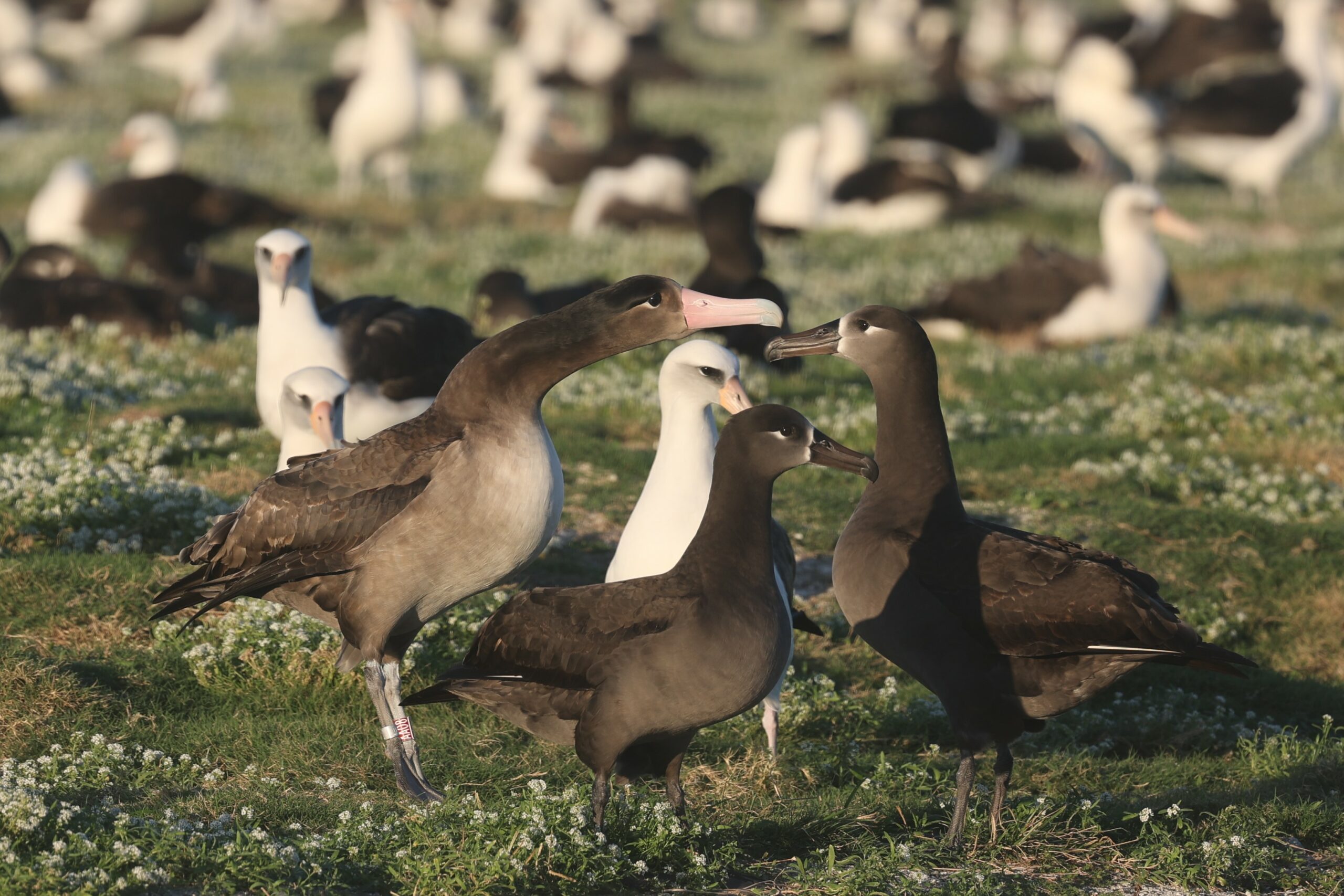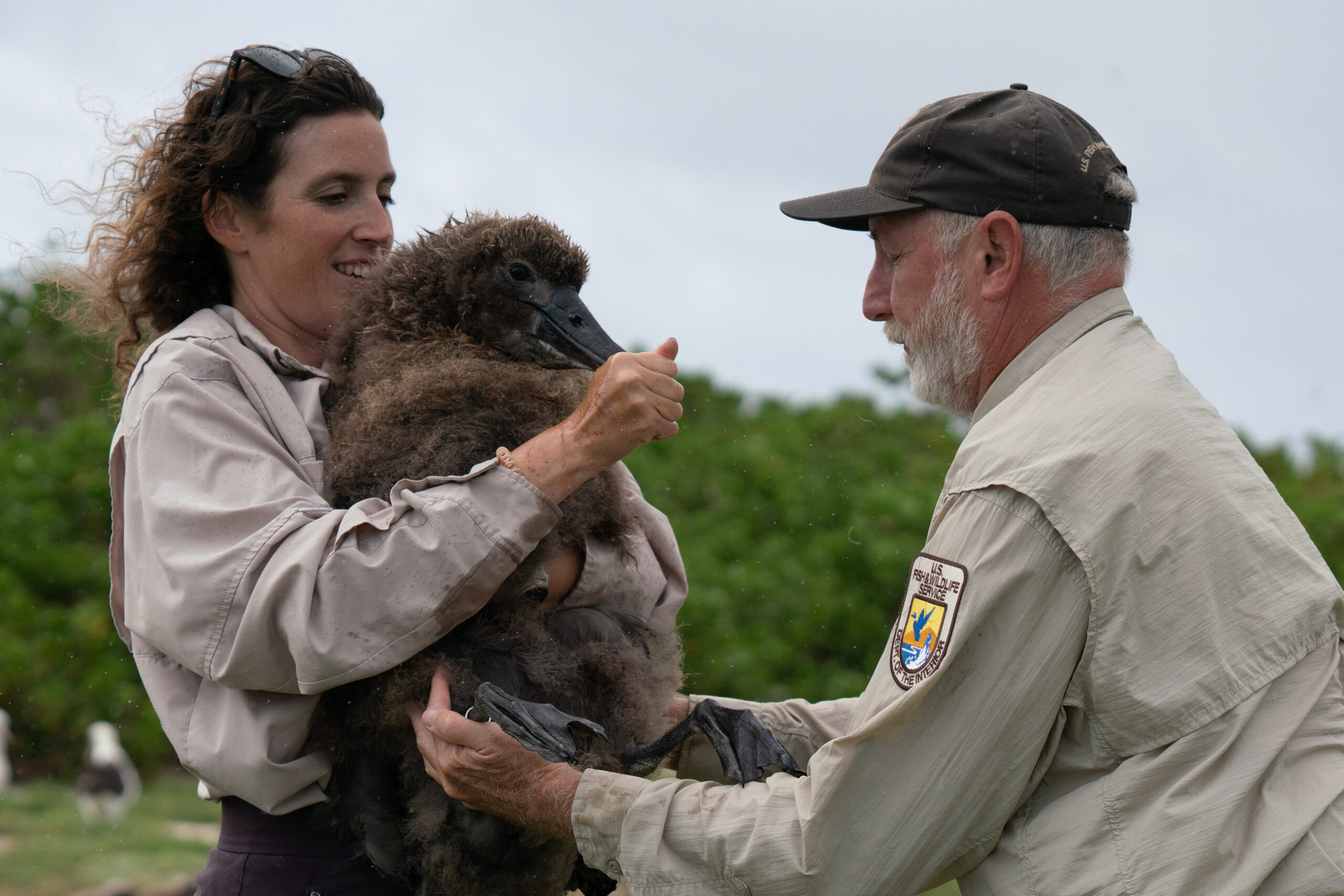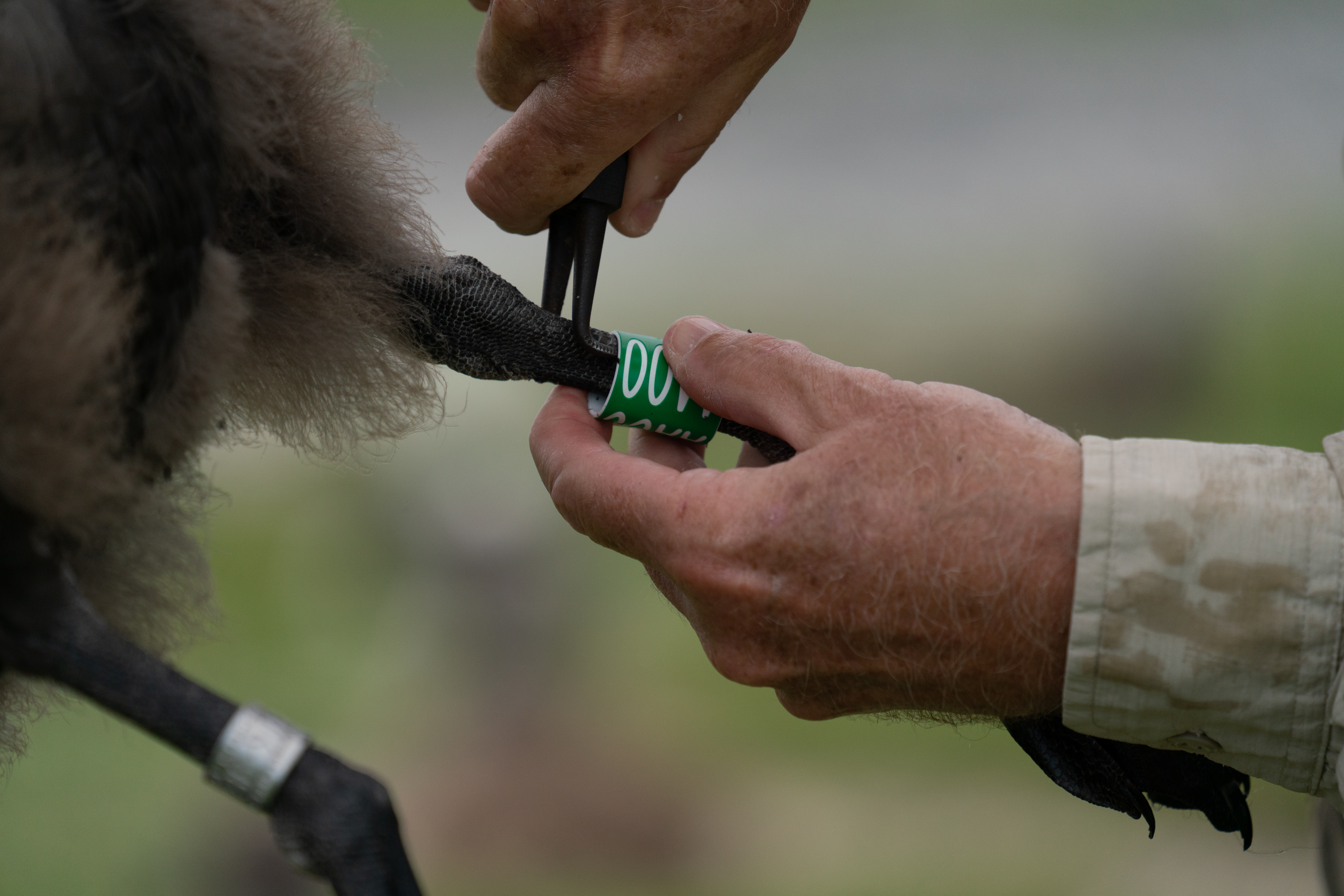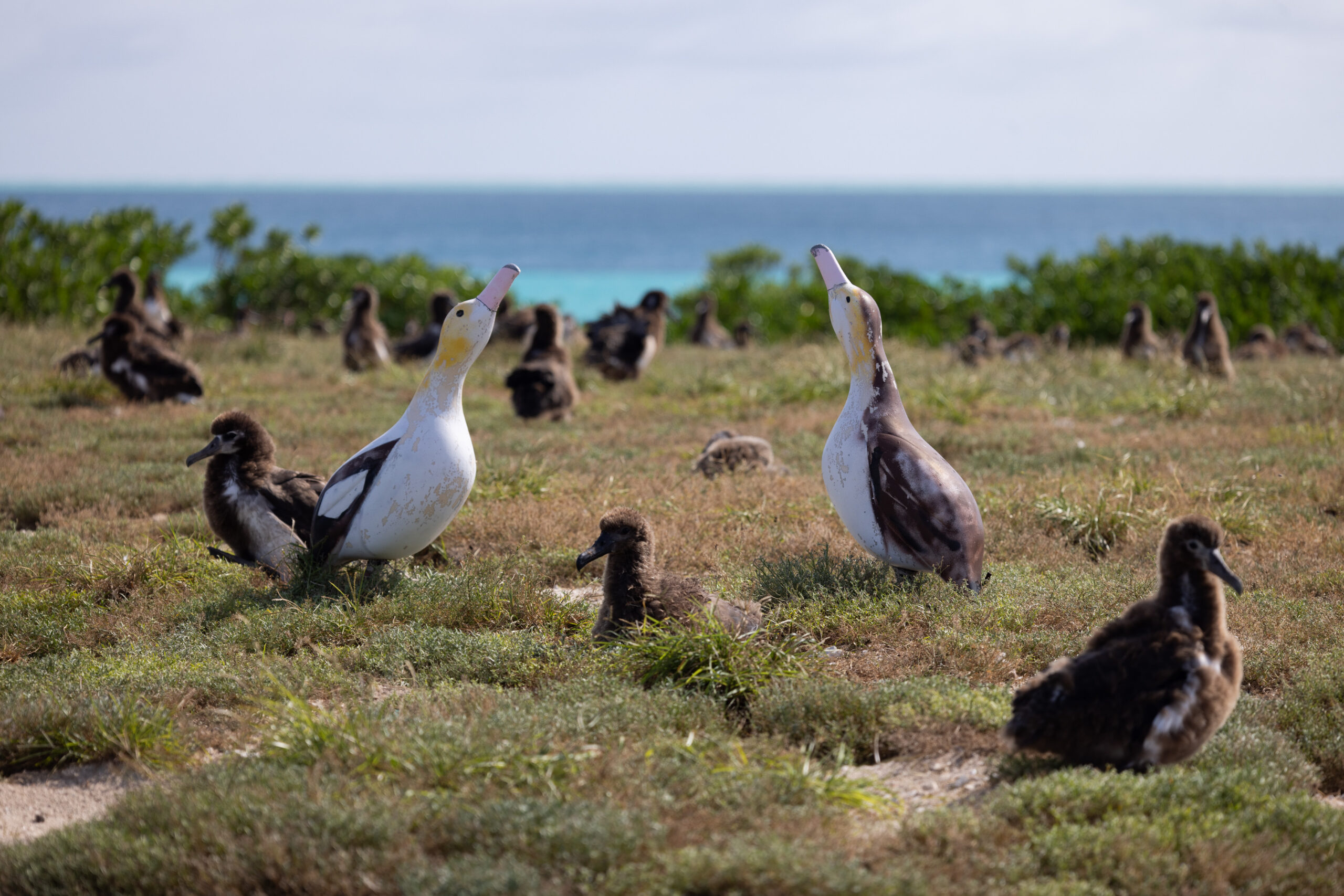One of the rarest of birds world-wide, a makalena (short-tailed albatross) chick was reared this past year on Sand Island near the south side of the runway and was first sighted on December the 27, 2022. During the months ahead the following chance moments proved exciting for the volunteers and staff who were at the right place at the right time!

A makalena (short-tailed albatross) chick possibly hatched on Christmas Day but it was first sighted on December 27, 2022. His father appeared to take his parental responsibilities seriously. photo by: USFWS Jon Plissner

What was particularly exciting was the steady appearance of the couple's 2019 chick near the nest AND was present for its sibling’s hatching! A wildlife camera funded by the Friends of Midway Atoll was focused on the nest 24/7 that gave biologists the chance to observe the chick and its parental care and feeding while also being able to document the comings and goings of the chick’s 4-year-old sibling. It is not unusual for albatross juveniles to return to their natal island before they are sexually mature.
Fast forward to January 2023 as Louise Barnfield and Jonathan Plissner were focusing their binoculars on the makalena nesting site. While observing the female brooding her young chick their keen eyes picked up on a makalena juvenile sitting nearby. They assumed it was the usual suspect, the new chick's 4-year-old sibling.
However, there was some confusion as they tried to lead another volunteer's gaze to the bird. Louise pointed to a spot near the bike path, while Jon indicated a spot further from the path. Lo and behold, there were actually TWO juveniles! Jon focused on the band number of the second, slightly darker youngster and determined that it was the second of the adult pair's four chicks (so far), which hatched on January 2, 2020!
In addition, another short-tailed albatross juvenile was often sighted in the ironwood tree forested area near the north side of island. Unfortunately, it didn't seem to connect to the seemingly ongoing family reunion happening on the south end of the Sand Island. However, it certainly was the first time in recent history that SIX short-tailed albatross were documented hanging on Kuaihelani!
In early April Jon Plissner, Chris Forster and the new acting refuge manager, Stewart Cogswell did a nest site visit when they were gifted with an unexpected treat. The 4-year-old juvenile and sibling of the new chick, spotted its father as it was trying to make its way out to sea after tending to its chick. Chris was thrilled she had her Iphone handy!
On April 16, 2023, the new chick received its first band. This is the fourth makalena chick to receive a band on Sand Island since 2019 (three chicks were banded on Eastern Island between 2011 and 2014).

Bio-technician Laura Brazier moved quickly while capturing the chick as Fish and Wildlife Service Supervisory Biologist Jon Plissner applied the band. Although the chick was comparatively huge it took less than 30 seconds. photo by: Andrew Sullivan-Haskins

In addition to their official #USGS uniquely-numbered metal band, this chick’s three older siblings received red plastic bands with bold white lettering, while this one received a green and white band. Albatross researchers of the 山階鳥類研究所 Yamashina Institute for Ornithology in Japan have also been using red and white bands for their short-tailed albatross and requested that a different color be used at Midway to quickly differentiate the birthplace of birds observed at sea or elsewhere. The chick seemed to be well fed by its parents and was caught in the action of interacting with its 4-year-old and 3-year-old siblings while a wildlife field camera funded by the #FriendsofMidwayAtoll captured daily behaviors and documented when the parents returned to feed the chick.
LIFT OFF!
On Tuesday afternoon (5/23), as the Fish and Wildlife Service’s four 6-month volunteers were checking on the ka’upu (black-footed albatross) they are monitoring south of the runway, they noticed the fully feathered ka’upu‘ākala or short-tailed albatross chick standing on the edge of the seawall, a kilometer away from its nest area. And as he usually does, Volunteer Alex Teodorescu had his camera with him and his telephoto lens. When the news was heard on the radio those currently here on Midway to support the Seabird Protection Project gathered to watch from an unobtrusive distance as the bird headed off into the southeasterly wind in a series of short flights and swims. The chick then followed the inner edge of the fringing reef eastward toward the ship channel. Despite the moderately strong winds and rough seas; the bird seemed to be faring well as it continued making its way south of Spit Island and out of sight. Segments of its flight captured by Alex can be viewed on the Friends of Midway Atoll YouTube Playlist at: https://www.youtube.com/playlist…
After reviewing the still images provided by the Friends of Midway Atoll funded game camera, the chick was still present near the nest on May 20th. The chick’s father was last at the nest site on May 5 and its mother was present from May 5-May 8. One of the chick's older siblings (either the 2019 or 2020 chick) revisited the site May 16-19.
Makalena once dominated the skies of the North Pacific. Their gorgeous feathers and approachability while nesting led partly to their demise as tens of thousands were slaughtered for their feathers that once adorned women's hats. This is the only known makalena nest outside of remote Torishima Island in Japan and the Senkaku Islands northwest of Taiwan.
Today, it is a different story because of people like you. The Friends of Midway Atoll recently supported, in addition to the wildlife camera, acoustic equipment.

Decoys were positioned on an elevated Sand Island location alongside a FOMA funded acoustic device that projected makalena vocalizations. Keep your fingers crossed this location becomes a new nest site, one that is not prone to flooding due to climate change.
For more information check-out this fascinating makalena timeline dated 2019 that was crafted by Kupu Intern/AmeriCorps Intern Elena Fischer, and visit this link to discover how Friends of Midway Atoll members helped bring back this species.
In the mid-1900's makalena were declared extinct, after feather hunters ravaged their breeding colonies and volcanic eruptions wiped out the last known nesting area on Torishima, a small Japanese island 375 miles south of Tokyo. Eventually, birds that were at sea when Torishima erupted returned to breed there; and through the conservation efforts of Japanese researchers, the colony has grown and once again become the primary nesting grounds for the species.
On Kuaihelani the chick’s parents, known as George and Geraldine, were originally banded on Torishima and are currently the only breeding pair nesting east of Japan.
